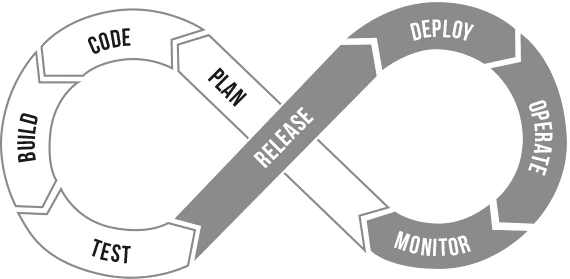Hi there 👋
How can I help you today?
DevOps is a methodology for software development that that emphasizes developer and operations team communication, increases speed, efficiency, and output. DevOps minimizes the number of steps in the software development lifecycle by integrating development and operations. It promotes timely feedback, which expedites the identification of any flaws or problems during the development process. This makes it an ideal strategy for large-scale enterprise.
The objective of DevOps is to promote the several strategies to improve software development workflow and outcomes. It encourages automation in software development (Dev) and operations. (Ops).
The DevOps lifecycle is a critical framework for modern software development and delivery. It is an example of a technological and cultural change that promotes teamwork, automation, and ongoing development. The way businesses develop, implement, and oversee their software applications has been completely transformed by this methodology. We'll examine the DevOps lifecycle in this blog post, looking at its main phases, guiding principles, and effects on the software development industry.
The DevOps lifecycle consists of 8 interconnected phases, each playing an important role in ensuring rapid, reliable, and continuous delivery of software.

As the name suggests, this phase is about defining the project, its requirements, scope, setting the objectives & prioritizing the tasks. In order to achieve it, teams need to be collaborated to orchestrate the software development process & finalizing the goals in-lined with the business objectives.
The actual development of the software is done in this phase. The business logic is put as a code & tested. A team of developers work together, write codes & conduct code reviews for its alignment with the business objectives. Continuous development & its continuous integration are key components in SDCL.
In this phase, the reviewed & finalized code which is also called as source code is compiled & packaged into an executable code. Automation plays a critical role in achieving consistent and repeatable builds and these can be achieved through build tools.
In this phase, several testing activities occur which includes unit tests to end-to-end testing. The automation of the testing process helps to identify & rectify issues in the beginning of the development process.
The release phase focuses on the readiness of an application for production. In addition to the continuous development & integration, continuous deployment plays a major role in the DevOps workflow. This can be achieved through automation of the release process using CI/CD tools. It eliminates deployment errors & reduces downtime.
In this phase the application is made available for end user which means it is get deployed on the production environment with the approved features & fixes if any.
The operate phase includes the management & maintenance of the application which is deployed in the production environment. The key activities in this phase are Monitoring & performance management, Incident management, Security & compliance, Log analysis & troubleshooting, Backup & disaster recovery, patch management. This phase concentrates on keeping the application operating steadily and dependably, preserving compliance, performance, and security, and handling errors and resource optimization.
Monitoring the application & its infrastructure is crucial to identify and rectify issues proactively. Monitoring tools track performances, user behavior, and system health. Product usage, along with any feedback, problems, or opportunities for improvement, are identified and recorded during the monitoring phase and then included in further development. This stage expedites the pipeline's development process and is crucial for organizing further iterations.
Along with these, collecting feedback from users and stakeholders is crucial for ongoing improvement. This feedback helps in identifying areas for enhancement and informs the planning phase of future iterations.
DevOps teams continuously strive to improve both the application and the DevOps process itself. This phase involves making enhancements, addressing technical debt, and refining the DevOps pipeline for more efficient and reliable software delivery.
The continuation of the above activities is crucial to maintain DevOps Workflow to get desired results.
DevOps automates processes and promotes collaboration, enabling organizations to release software more quickly
Constant testing and observation result in software that is more reliable and has fewer errors.
Automation lowers deployment errors, which contributes to decreased downtime and increased service dependability.
By lowering development and deployment barriers, DevOps promotes an environment of experimentation and creativity.
In the field of software development, the DevOps lifecycle is revolutionary. Organizations can deliver software more quickly, with better quality, and with fewer disruptions when automation, collaboration, and continuous improvement are prioritized. DevOps is a fundamental framework for today's software development teams because it can result in increased customer satisfaction, cost savings, and efficiency gains.


